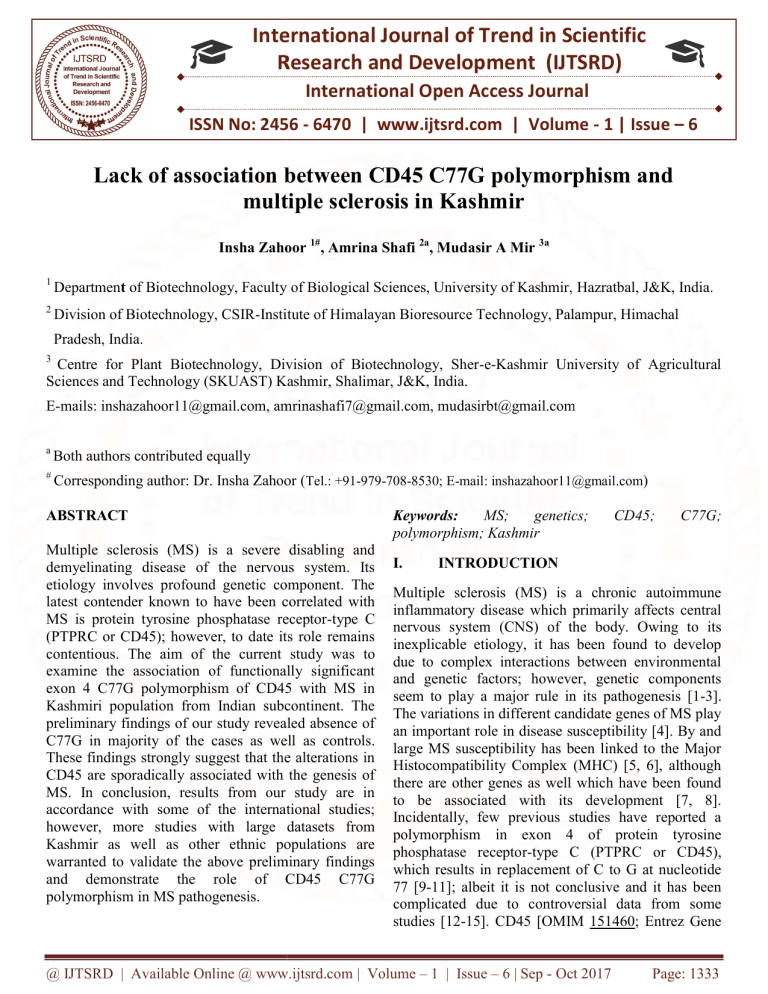
International Journal of Trend in Scientific
Research and Development (IJTSRD)
International Open Access Journal
ISSN No: 2456 - 6470 | www.ijtsrd.com | Volume - 1 | Issue – 6
Lack of association between CD45 C77G polymorphism and
multiple sclerosis in Kashmir
Insha Zahoor 1#, Amrina Shafi 2a, Mudasir A Mir 3a
1
Department of Biotechnology, Faculty of Biological Sciences, University of Kashmir, Hazratbal, J&K, India.
2
Division of Biotechnology, CSIR-Institute
Institute of Himalayan Bioresource Technology, Palampur, Himachal
Pradesh, India.
3
Centre for Plant Biotechnology, Division of Biotechnology, Sher
Sher-e-Kashmir
Kashmir University of Agricultural
Sciences and Technology (SKUAST) Kashmir, Shalimar, J&K, India.
E-mails:
mails: inshazahoor11@gmail.com, amrinashafi7@gmail.com, mudasirbt@gmail.com
a
Both authors contributed equally
#
Corresponding author: Dr. Insha Zahoor (Tel.: +91-979-708-8530; E-mail: inshazahoor11@gmail.com)
ABSTRACT
Multiple sclerosis (MS) is a severe disabling and
demyelinating disease of the nervous system. Its
etiology involves profound genetic component. The
latest contender known to have been correlated with
MS is protein tyrosine phosphatase receptor
receptor-type C
(PTPRC or CD45); however, to date its role remains
contentious. The aim of the current study was to
examine the association of functionally significant
exon 4 C77G polymorphism of CD45 with MS in
Kashmiri population from Indian subcontinent. The
preliminary findings of our study revealed absence of
C77G in majority of the cases as well as controls.
These findings strongly suggest that the alterations in
CD45 are sporadically associated with the genesis of
MS. In conclusion, results from our study are in
accordance with some of the international studies;
however, more studies
es with large datasets from
Kashmir as well as other ethnic populations are
warranted to validate the above preliminary findings
and demonstrate the role of CD45 C77G
polymorphism in MS pathogenesis.
Keywords:
MS;
genetics;
polymorphism; Kashmir
I.
CD45;
C77G;
INTRODUCTION
Multiple sclerosis (MS) is a chronic autoimmune
inflammatory disease which primarily affects central
nervous system (CNS) of the body. Owing to its
inexplicable etiology, it has been found to develop
due to complex interactions between environmental
and genetic factors; however, genetic components
seem to play a major rule in its pathogenesis [1-3].
[1
The variations in different candidate genes of MS play
an important
ant role in disease susceptibility [4]. By and
large MS susceptibility has been linked to the Major
Histocompatibility Complex (MHC) [5, 6], although
there are other genes as well which have been found
to be associated with its development [7, 8].
Incidentally,
ally, few previous studies have reported a
polymorphism in exon 4 of protein tyrosine
phosphatase receptor-type
type C (PTPRC or CD45),
which results in replacement of C to G at nucleotide
77 [9-11];
11]; albeit it is not conclusive and it has been
complicated due to
o controversial data from some
studies [12-15]. CD45 [OMIM 151460; Entrez Gene
@ IJTSRD | Available Online @ www.ijtsrd.com | Volume – 1 | Issue – 6 | Sep - Oct 2017
Page: 1333
International Journal of Trend in Scientific Research and Development (IJTSRD) ISSN: 2456-6470
5788] is located on chromosome 1 at position q31.3q32.1 and belongs to the family of protein tyrosine
phosphatase (PTP). It plays a critical role in
regulating protein-tyrosine kinases involved in signal
transduction thereby activating T and B cells [16, 17].
Keeping in view its essentiality for the functioning of
immune system, we investigated the association
between CD45 and MS in an Indian population,
covering the patients from Kashmir region.
II. Materials and Methods
2.1 Study participants
A total of 20 unrelated MS patients from Kashmir
region of India were recruited for the present study
from the In Patient Department (IPD) and Out Patient
Department (OPD) of the Department of Neurology,
Sher-I-Kashmir Institute of Medical Sciences
(SKIMS), Soura, Kashmir, India; following the proper
ethical procedures of the hospital. All the MS cases
were relapsing-remitting (RR) type and diagnosis was
made by the neurologist (RA) according to 2010
Revised McDonald Diagnostic criteria [18]. The local
Institutional Ethics Committee of SKIMS reviewed
and approved this study (No. SKIMS 1 31/IECSKIMS/2013-6380). Informed consent was acquired
from all subjects prior to enrolment. All procedures
performed with human participants and their samples
were in accordance with the ethical standards of the
institutional research committee and 1964 Helsinki
declaration and its later amendments or comparable
ethical standards.
2.2 Blood sample collection and DNA extraction
2 ml of whole peripheral venous blood was collected
from the RRMS cases and controls in EDTA coated
Vacutainer tubes (ADS Hitech Polymers, India) and
stored at -80°C before processing for DNA extraction.
Blood samples were also collected from healthy
individuals from the same geographic area to serve as
controls. Genomic DNA was extracted from the blood
leukocytes by using DNeasy® Blood & Tissue Kit
(Qiagen, Germany), according to the manufacturer’s
enclosed protocol and its integrity and specificity was
checked on 0.8% agarose gel by comparing with 1 kb
DNA ladder (Fermentas, USA). The concentration of
extracted DNA samples was determined by using
NanoDropTM Spectrophotometer (Thermo Fisher
Scientific, USA) and stored at -20°C till further
processing.
2.3 CD45 amplification
The amplification of CD45 exon 4 was performed
using the newly designed primer sequences (Forward
Primer: 5' GCAAAGATGCCCAGTGTTCC 3' and
Reverse Primer:
5' TTGTGTGCCAACCTGTGGTA 3'). PCR was
carried out in thermal cycler (Benchmark TC9639,
USA), at respective annealing temperatures (Tm) of
primer sets obtained after optimization, in a reaction
volume of 50 µl containing 50-100 ng of genomic
DNA, 0.2 mM dNTPs (Thermo Scientific, USA), 1x
Phusion HF Buffer (New England Biolabs, Inc. USA),
1U of Phusion DNA Polymerase (New England
Biolabs, Inc. USA) and 0.4 µM of each primer
(Imperial Life Sciences, India). Amplification was
performed by initial denaturation at 98°C for 5 min,
followed by 30 cycles of denaturation at 98°C for 30
s, annealing at 57°C for 45 s, extension at 72°C for 1
min and a final extension at 72°C for 5 min, after the
last cycle. The specificity of amplified products was
checked by analyzing on 1.5% agarose gel and
comparing with 100 bp DNA ladder (Thermo Fisher
Scientific, USA). Purification of PCR products was
done by using the GenEluteTM Gel Extraction Kit
(Sigma-Aldrich,
USA),
according
to
the
manufacturer’s instructions and samples were then
stored at -20°C till sequencing.
2.4 Sequencing
For examining C77G polymorphism in CD45, the
amplified products were sequenced commercially
through the services of SciGenom Labs, Pvt., Ltd.,
Kerala, India (http://www.scigenom.com). Nucleotide
sequences of the amplicons were viewed and analyzed
for alterations by comparing with NCBI reference
sequence using ClustalX Version 2 [19, 20], Chromas
Pro
Version
1.49
beta
2
(http://www.technelysium.com.au) and Finch TV
(http://www.geospiza.com). Databases such as
Human Gene Mutation Database (HGMD;
http://www.hgmd.cf.ac.uk),
NCBI′s
SNP
(http://www.ncbi.nlm.nih.gov/snp)
and
PubMed
databases
(http://www.ncbi.nlm.nih.gov/pubmed)
were consulted for the detection of C77G.
@ IJTSRD | Available Online @ www.ijtsrd.com | Volume – 1 | Issue – 6 | Sep - Oct 2017
Page: 1334
International Journal of Trend in Scientific Research and Development (IJTSRD) ISSN: 2456-6470
2456
III. Results and Discussion
The present study comprised of 20 RRMS patients as well as contro
controls
ls from the Indian data set, covering the
patients from its northern region Kashmir. All the subjects were of the Kashmiri ethnicity. Agarose gel
electrophoresis revealed successful extraction of DNA from blood samples of both cases as well as controls
(Fig.
g. 1). The extracted DNA was used as a template for amplification of CD45 gene and PCR products on
analysis showed specific bands on the agarose gel as per expected size of 199 bp (Fig. 2). After analysis of
sequence alignment and chromatograms of nucleoti
nucleotide
de sequences of samples, C77G was found to be absent in
cases as well as controls (Fig. 3).
Figure 1. Representative 0.8% agarose gel showing
DNA extracted from study subjects. 2 µl (100
(100-200
ng/µl) of each sample was loaded in each well. [Lane
M shows separation pattern of 1 kb ladder; and lanes
1 to 5 show genomic DNA].
Figure 2. Representative 1.5% agarose gel showing
specific PCR amplification product of CD45 (199 bp)
in study subjects. 2 µl (100-200
(100
ng/µl) of each
sample was loaded in each well. [Lane M shows
separation pattern of 100 bp ladder; and lanes 1 to 8
show desired product].
(a)
(b)
Figure 3. Representative sequence chromatograms showing the absence of CD45 C77G polymorphism in MS
case (a) and control (b).
@ IJTSRD | Available Online @ www.ijtsrd.com | Volume – 1 | Issue – 6 | Sep - Oct 2017
Page: 1334
International Journal of Trend in Scientific Research and Development (IJTSRD) ISSN: 2456-6470
The development of MS is a complex and multifactorial process mediated by various genetic and
environmental factors involving numerous related
pathways [1, 3, 8, 21]. It has been seen that genetic
alterations contribute to the genesis of MS [8]. To a
large extent, progress has been attained in recognizing
the candidate genes and gene defects that underlie
inherited predisposition to MS. Therefore, screening
of MS candidate genes for genetic variations can
further clarify the relationship between genetics of
MS and its development. Even though there is paucity
of reports on the association between MS and CD45,
some previous studies have reported C77G
polymorphism in exon 4 of CD45 among MS patients
from different ethnic backgrounds [9-11]. Keeping in
view the association between C77G polymorphism of
CD45 with MS, we screened this variant in ethnic
cohort of Kashmiri patients as our population being
small, isolated, and containing conserved gene pool
makes it a right candidate for gene analysis study.
Sequence analysis indicated that no alteration exists in
CD45 in MS patients from Kashmir valley of India.
This study strongly suggests that alterations present in
MS patients vary from population to population and it
can be inferred that alterations found in one
population may not be necessarily present in MS
patients from other geographic area as both
environmental as well as genetic factors influence MS
development. Thus, it can be suggested that
alterations in CD45 are infrequently associated with
the genesis of MS and its association with MS
susceptibility strongly depends on environmental
factors.
IV. Conclusion
To the best of our knowledge, this is the first study
from India in which we examined the presence of
C77G polymorphism in CD45 gene in Kashmiri
population. Our preliminary findings clearly revealed
absence of C77G polymorphism in MS patients as
well as controls. However, keeping in view primary
limitation of our study due to very small sample size,
it becomes mandatory to validate our findings by
taking into account large datasets from Kashmir
region of India.
Acknowledgment
We wish to express our deepest gratitude to all the
subjects for their participation in this study. We are
highly indebted to Dr. Ravouf Asimi, Additional
Professor, Department of Neurology, Sher-I-Kashmir
Institute of Medical Sciences (SKIMS), Soura, J&K,
India, for providing help in sample collection.
Conflict of interest
The authors declare no potential conflicts of interest
with respect to the research, authorship and/or
publication of this article.
References
1) G.C. Ebers, Environmental factors and multiple
sclerosis. Lancet Neurol, 7, 268-77, 2008.
2) D.S. Goodin, The genetic basis of multiple
sclerosis: a model for MS susceptibility. BMC
Neurol, 10, 101, 2010.
3) S.V. Ramagopalan, R. Dobson, U.C. Meier, and
G. Giovannoni, Multiple sclerosis: risk factors,
prodromes, and potential causal pathways. Lancet
Neurol, 9, 727-39, 2010.
4) A.D. Sadovnick, P.A. Baird, and R.H. Ward,
Multiple sclerosis: updated risks for relatives. Am
J Med Genet 29, 533-41, 1988.
5) J.R. Oksenberg, L.F. Barcellos, B.A. Cree, S.E.
Baranzini, T.L. Bugawan, O. Khan, et al. Mapping
multiple sclerosis susceptibility to the HLA-DR
locus in African Americans. Am J Hum Genet, 74,
160-7, 2004.
6) O. Olerup, and J. Hillert, HLA class II-associated
genetic susceptibility in multiple sclerosis: a
critical evaluation. Tissue Antigens, 38, 1-15,
1991.
7) C.F. Brosnan, L. Battistini, Y.L. Gao, C.S. Raine,
and D.A. Aquino, Heat shock proteins and
multiple sclerosis: a review. J Neuropathol Exp
Neurol, 55, 389-402, 1996.
8) .A. Dyment, G.C. Ebers, and A.D. Sadovnick,
Genetics of multiple sclerosis. Lancet Neurol, 3,
104-10, 2004.
9) C. Ballerini, E. Rosati, M. Salvetti, G. Ristori, S.
Cannoni, T. Biagioli, et al. Protein tyrosine
phosphatase receptor-type C exon 4 gene mutation
distribution in an Italian multiple sclerosis
population. Neurosci Lett, 328, 325-7, 2002.
@ IJTSRD | Available Online @ www.ijtsrd.com | Volume – 1 | Issue – 6 | Sep - Oct 2017
Page: 1336
International Journal of Trend in Scientific Research and Development (IJTSRD) ISSN: 2456-6470
10) M. Jacobsen, D. Schweer, A. Ziegler, R. Gaber, S.
Schock, and R. Schwinzer, A point mutation in
PTPRC is associated with the development of
multiple sclerosis. Nat Genet, 26, 495-9, 2000.
11) T. Vyshkina, T.P. Leist, Y.Y. Shugart, and B.
Kalman, CD45 (PTPRC) as a candidate gene in
multiple sclerosis. Mult Scler, 10, 614-7, 2004.
12) L.F. Barcellos, S. Caillier, L. Dragone, M. Elder,
E. Vittinghoff, P. Bucher, et al. PTPRC (CD45) is
not associated with the development of multiple
sclerosis in U.S. patients. Nature Genet, 29, 23-24,
2001.
13) E. Cocco, M.R. Murru, C. Melis, L. Schirru, E.
Solla, M. Lai, et al. PTPRC (CD45) C77G
mutation does not contribute to multiple sclerosis
susceptibility in Sardinian patients. J Neurol, 251,
1085-1088, 2004.
14) A.L. Szvetko, A. Jones, J. Mackenzie, L. Tajouri,
P.A. Csurhes, J.M. Greer, et al. An investigation
of the C77G and C772T variations within the
human protein tyrosine phosphatase receptor type
C gene for association with multiple sclerosis in
an Australian population. Brain Res 1255, 148152, 2009.
15) I. Vorechovsky, J. Kralovicova, E. Tchilian, T.
Masterman, Z. Zhang, B. Ferry, et al. Does 77C-G
in PTPRC modify autoimmune disorders linked to
the major histocompatibility locus? Nature Genet,
29, 22-23, 2001.
16) I.S. Trowbridge, and M.L. Thomas, CD45: an
emerging role as a protein tyrosine phosphatase
required for lymphocyte activation and
development. Annu Rev Immunol, 12, 85-116,
1994.
17) A. Weiss, and D.R. Littman, Signal transduction
by lymphocyte antigen receptors. Cell, 76, 263-74,
1994.
18) C.H. Polman, S.C. Reingold, B. Banwell, M.
Clanet, J.A. Cohen, M. Filippi, et al. Diagnostic
criteria for multiple sclerosis: 2010 revisions to
the McDonald criteria. Ann Neurol, 69, 292-302,
2011.
19) M.A. Larkin, G. Blackshields, N.P. Brown, R.
Chenna, P.A. McGettigan, H. McWilliam, et al.
Clustal W and Clustal X version 2.0.
Bioinformatics, 23, 2947-8, 2007.
20) J.D. Thompson, T.J. Gibson, F. Plewniak, F.
Jeanmougin,
and
D.G.
Higgins,
The
CLUSTAL_X windows interface: flexible
strategies for multiple sequence alignment aided
by quality analysis tools. Nucleic Acids Res, 25,
4876-82, 1997.
21) A. Ascherio, and K.L. Munger, Environmental
risk factors for multiple sclerosis. Part I: the role
of infection. Ann Neurol, 61, 288-99, 2007.
@ IJTSRD | Available Online @ www.ijtsrd.com | Volume – 1 | Issue – 6 | Sep - Oct 2017
Page: 1337

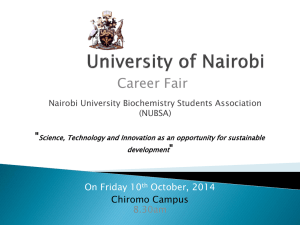
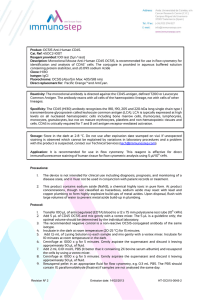
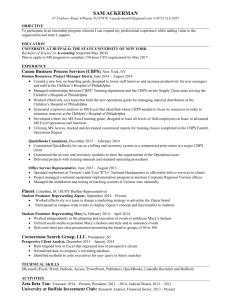
![Anti-CD45.1 antibody [A20] (Phycoerythrin) ab25012 Product datasheet Overview Product name](http://s2.studylib.net/store/data/012441189_1-10714f743dd66a9c9a71f99955090157-300x300.png)
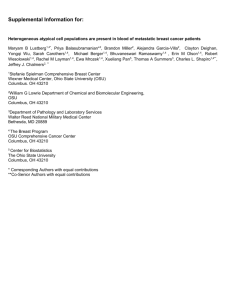

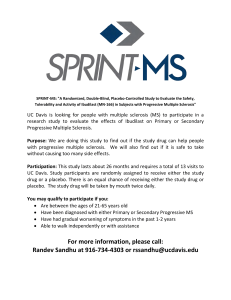
![Anti-CD45.1 antibody [A20] (FITC) ab24917 Product datasheet 1 Abreviews 1 Image](http://s2.studylib.net/store/data/012441186_1-1a06e52061dc25050c20ab8224dedfdb-300x300.png)